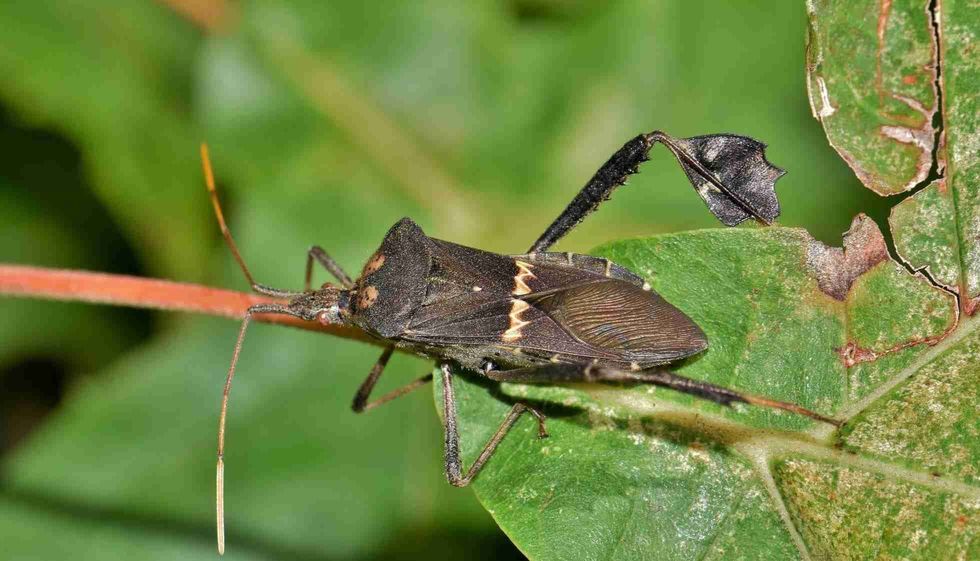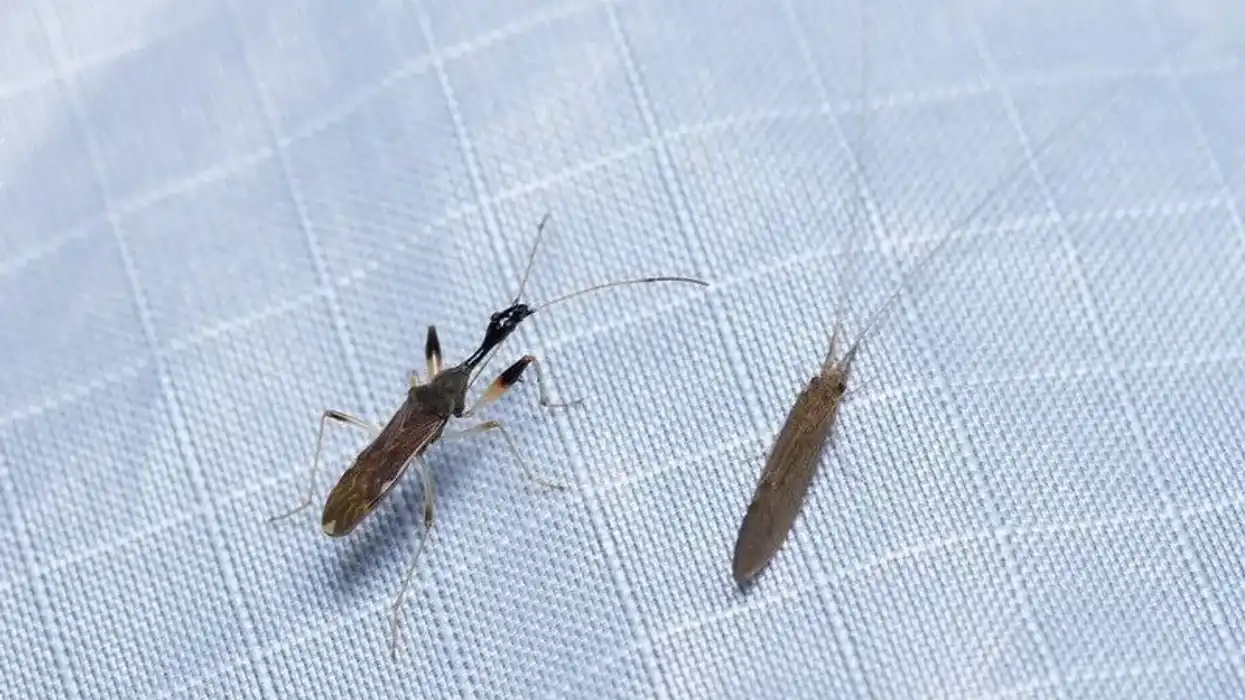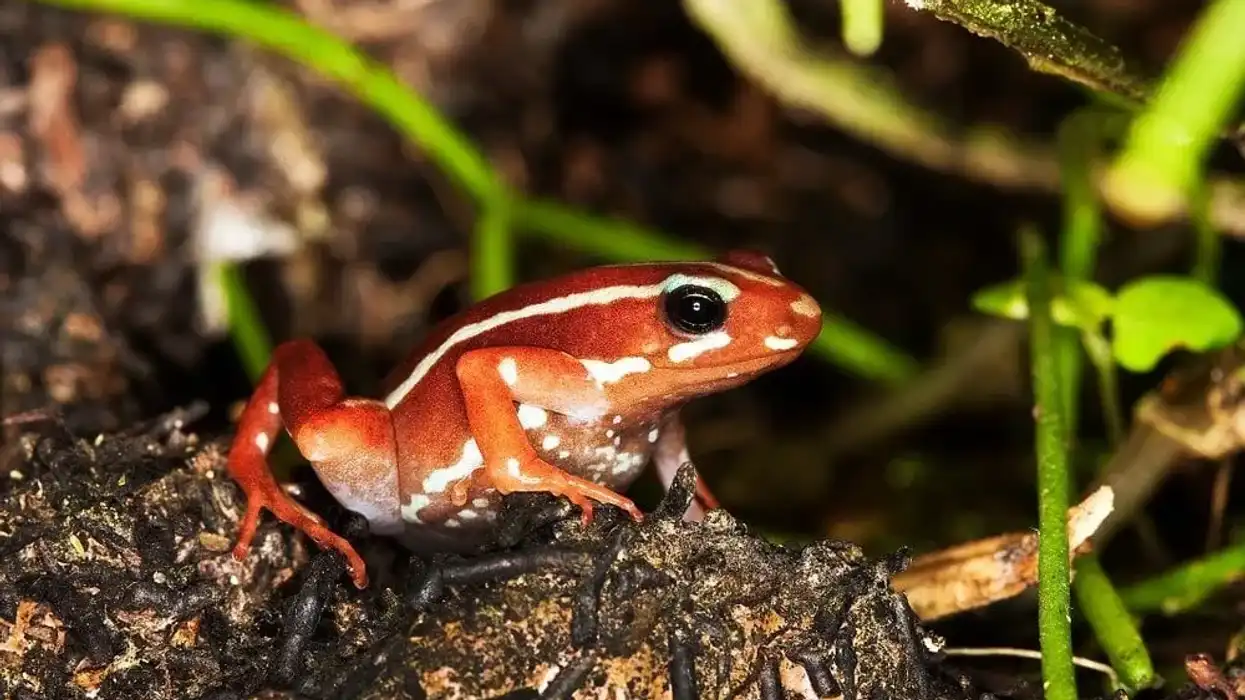A leaf-footed bug (scientific name Leptoglossus phyllopus) is a medium to large-sized insect. There are different types of species and subspecies with different types of color and traits.
A leaf-footed plant bug is known as leaf-footed due to the leaf-like expansion on the hind leg. They have oval-shaped bodies, with antennae with four segments and many veins in the membrane of the forewings as well as external visible repugnatorial stink glands.
Some species have elongated parallel sides, and some are slender. Some leaf-footed plant bug species have tubercles and spines.
Some robust species have grossly big, thick, and bowed hind femora with spikes on the inner edge. They suck on sap from plants and like to feed on crops, plants, and developing fruits especially tomatoes, peaches and cotton. Some species are known to be carnivores.
A leaf-footed bug is known as a pest in parts of the world. A western leaf-footed bug is not that harmful as their damage is limited to gardens and parks.
They do not come in large numbers. Various species of leaf-footed bugs are present in the wild such as northern leaf-footed bug, eastern leaf-footed bug, western leaf-footed bug and the giant leaf-footed bug.
Picking western leaf-footed bug (Leptoglossus zonatus) while clearing the garden of weeds and other unwanted items, such as western conifer seed bug (Leptoglossus occidentalis), could do the trick of keeping their population at bay. Groups of nymphs can be reduced by using some natural insecticides on them.
Feeding by these insects causes spotting and pitting of the seeds or half-eaten fruits.
After reading the leaf footed plant bug facts, do check out our other articles on imperial moth and ladybird.
Leaf-Footed Bug Interesting Facts
What type of animal is a leaf-footed bug?
Leaffooted bugs, or Hemiptera coreidae, are a type of dark colored insect. There are many variants, species, and subspecies found in various regions of the world across gardens, fruit orchards, farmland, forests, and woodlands. It gets the name from a leaf-like extension on the hind legs.
What class of animal does a leaf-footed bug belong to?
The leaffooted bug (Leptoglossus phyllopus) belongs to the insecta class of animals. Leaffooted bugs are known as squash bugs too.
Some of the variants of this species include black leaffooted bug, leaf-footed pine seed bug, leaf-footed assassin bug and leaf-footed plant bug. They use their sucking mouthpart in order to pierce the fruit or flower for nectar. They can cause some damage to crops and fruits, hence professional pest control must be used to control their effects.
How many leaf-footed bugs are there in the world?
The exact number of leaffooted bugs in the world is not easy to find as it has many subspecies. Also, because of its pest status, the adult as well as the nymph are sometimes exterminated. So it is difficult to count and find exact numbers for the leaffooted bug species.
Where does a leaf-footed bug live?
The leaffooted bug can be found in gardens, farmlands, forests, fruit orchards, woodlands, and jungles. These pests are found on trees and near plants.
Leaffooted bugs are found in many places over the world. There is not a place in the world where there will not be a variant or subspecies of these insects. Hemiptera coreidae overwinter as adults in safe regions that can include human habitat as well.
What is a leaf-footed bug's habitat?
The leaffooted bug (Leptoglossus phyllopus) is found in a lot of places across America, including Ontario, Massachusetts, Florida, West Virginia, Arkansas, and Texas. They are also found in South America and Southeast Asia.
These pests are found in large numbers on the island of Borneo in the Pacific. They are also found in Australia, American Samoa, Fiji, French Polynesia, Guam, Micronesia, North Mariana Island, Palau, Papua New Guinea, Samoa, Solomon Islands, Tonga, Vanuatu, Wallis, and Futuna.
Who do leaf-footed bugs live with?
Leaf-footed bugs (Leptoglossus phyllopus) may be lonely creatures, but these pests live with similar species.
How long does a leaf-footed bug live?
The adult leaf-footed bug (Leptoglossus phyllopus) may live for two weeks. In the nymph stage, this pest may live for 40 to 50 days. During winter time they prefer to live in protected areas.
How do they reproduce?
The female leaf-footed bug (Leptoglossus phyllopus) lays eggs on stems and leaves batches of 30 eggs at a time. After six or seven days the eggs hatch, and the nymph stage begins. In this stage, the nymphs feed on the plants by sucking on their juices.
There are five stages of the nymphs, which are complete in 40 to 50 days. They are reddish in color, and as they clear each stage, the color becomes darker. As they become adult, these bugs become black or dark brown in color.
What is their conservation status?
The conservation status for the leaf-footed bug (Leptoglossus phyllopus) is Least Concern as there is not much decline in their population. Hemiptera coreidae are considered as a pest, but the damage caused by them is not that severe or threatening.
Leaf-Footed Bug Fun Facts
What do leaf-footed bugs look like?
Leaf-footed bugs have very long sucking mouthparts. These mouthparts are almost as long as their bodies.
They use this to feed on fruits mostly. Adults can grow to the length of 0.75 in (1.9 cm). This pet is called a leaf-footed bug because of the leaf-like growth on their hind legs, which helps them to stick to a leaf or a fruit for a longer duration.
How cute are they?
The western leaf-footed bugs (Leptoglossus zonatus) may be cute for some. But they are such small creatures, and can cause some damage to plants, therefore, they are considered to be pests. They are small creatures who suck on the different parts of the plants, which causes minor damages to them.
How do they communicate?
They may make buzzing sounds as they fly. If the adults are disturbed, they may give off a bad odor as a defense. Apart from this, not much is known about their vocal or non-vocal communication.
How big is a leaf-footed bug?
As per insect sizes, the western leaf-footed bugs (Leptoglossus zonatus) are considered large insects. They grow to a size of 0.75 in (1.9 cm).
How fast can leaf-footed bugs move?
The exact speed may not be known for leaf-footed bugs. They are insects found in most parts of the world. They are known to have many subspecies and variants. However, they are mostly seen walking instead of flying.
How much does a leaf-footed bug weigh?
The leaf-footed bug may weigh between 0.08-0.17 lb (1.4-2.8 oz) depending on nymph or adult stages. They are somewhat large insects found in gardens and farmlands.
What are the male and female names of the species?
The male and female names for leaf-footed bugs are not known. They may be simply called male and female leaf-footed bugs or squash bugs.
What would you call a baby leaf-footed bug?
A leaf-footed baby bug is called a leaf-footed bug nymph. Leaf-footed bug nymphs pass through five stages in their life cycle to reach adulthood.
What do they eat?
The western leaf-footed bugs (Leptoglossus zonatus) suck on the juicy parts of the plants like the sap, fruit, stem, nature seeds, or leaves. Hemiptera coreidae affect plants like citrus, cucumbers, passionfruit, almonds, pistachios, or pomegranates.
Are they harmful?
Leaf-footed bugs do not pose any threat to humans as such. The damage they cause the plants is also superficial. They do not attack any plant in great numbers to cause lasting damage, but they can be quite annoying. A leaf-footed bug bite is not a serious concern for humans.
Would they make a good pet?
They are insects which can be considered as a pet. We can keep them in captivity or breed them in captivity to understand their life cycle better. Leaf-footed bugs are fascinating creatures because they are available in hundreds of varieties and subspecies. But they cause a lot of damage to plants, crops, and fruits.
Did you know...
Some leaf-footed bugs are orange, yellowish, or tan in colors and may have contrasting color tones. They are also called coreids or squash bugs. They have large mouthparts which help them suck the juices from the plants.
Leaf-footed bugs belong to the family of true bugs. The assassin bugs, praying mantis, spiders and wasps are known to destroy eggs and prey on nymphs.
The nymphs are five wingless nymphal instars. They have black legs, and their bodies are orangish to reddish-brown in color. The instars do not have the defining feature of the leaf-footed tibia.
Are leaf-footed bugs the same as stink bugs?
No, even though some people call them stink bugs, they are different. The stink bugs have green or brown-colored shield-shaped bodies. Leaf-footed bugs have more cylindrical straight bodies in a reddish-brown color. They only suck on plants, whereas the stink bugs are omnivores. The stink bugs do not have leaf-shaped paws on their hind legs like leaf-footed bugs.
How to get rid of leaf-footed bugs?
Leaf-footed bugs grow on the leaves and stem of crops, plants and trees. They are attracted to the juiciest parts of the plant. Weed management is the key to keep them at bay.
Handpick the insects from the tree or plant and use mild natural insecticides on them to clear them off completely. It is easy to handpick them from a tree as they are slow and rarely in large numbers. A pyrethroid-based insecticide is the most effective management solution against the nymphs as well as adults.
Here at Kidadl, we have carefully created lots of interesting family-friendly animal facts for everyone to discover! Learn more about some other arthropods including Mexican red-knee tarantula, or bald-faced hornet.
You can even occupy yourself at home by drawing one of our Leaf-footed bug coloring pages.










